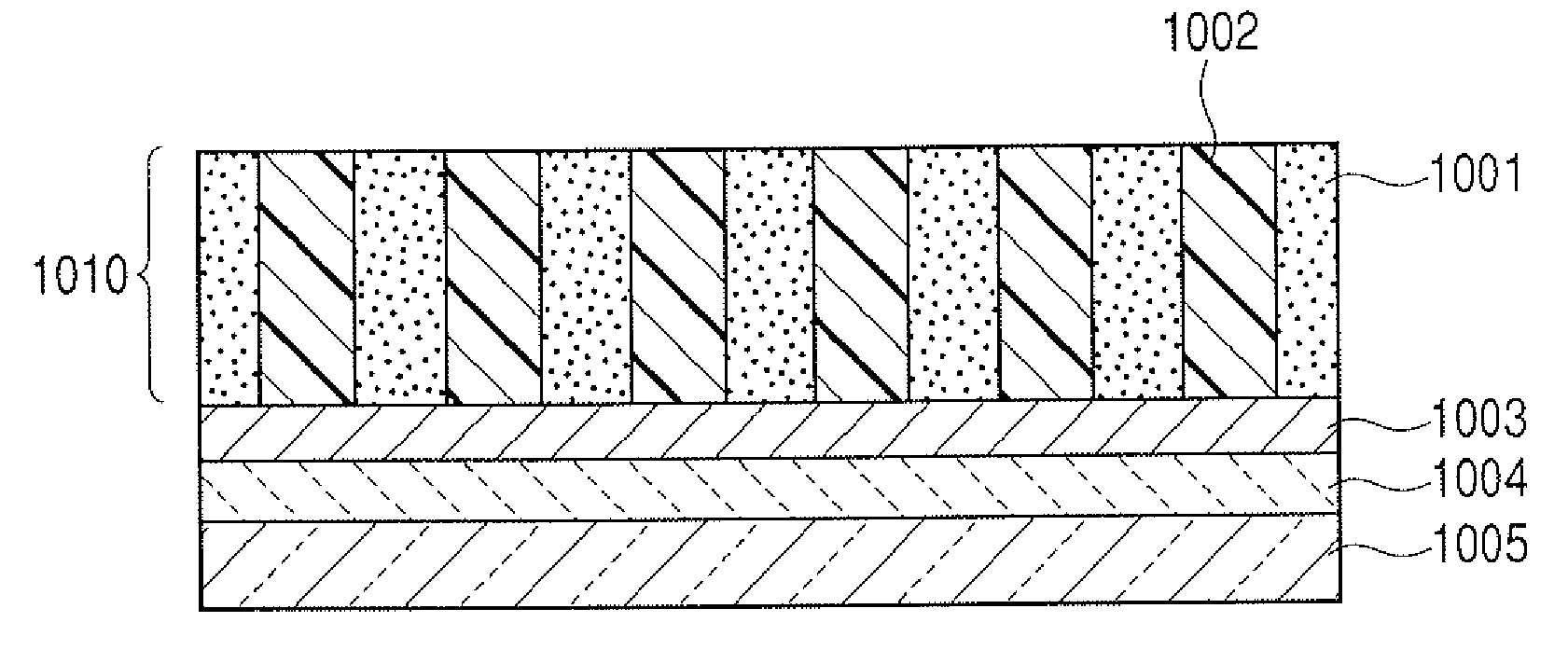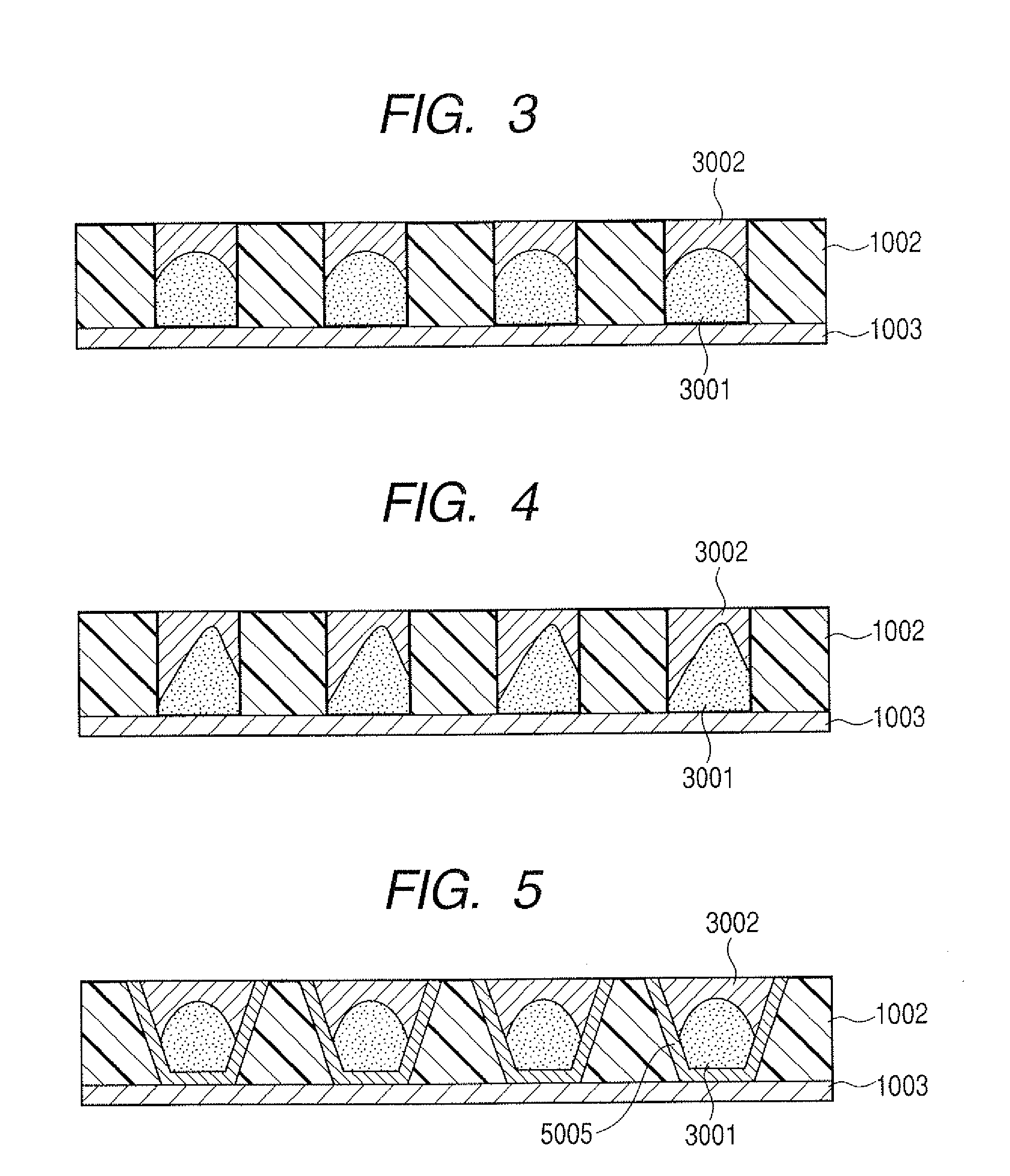Structure and process for production thereof
a technology of high-density recording and structure, applied in the field of structure for high-density recording, can solve the problems of insufficient recording capability, insufficient magnetic recording medium sensitivity to external magnetic field for recording, and disadvantages of magnetic recording, so as to improve the recording sensitivity of magnetic recording medium and maintain thermal fluctuation resistance
- Summary
- Abstract
- Description
- Claims
- Application Information
AI Technical Summary
Benefits of technology
Problems solved by technology
Method used
Image
Examples
example 1
[0070]A porous member having pores of 20 nm diameter at pore intervals of 30 nm and an aspect ratio of 1 is prepared as described below.
[0071]A (001)-oriented MgO layer (20 nm thick) is prepared on a substrate. On this MgO layer, a thin Pt film of 10 nm thick is formed by magnetron sputtering. On this thin Pt film, a Ti film of 1 nm thick is formed. This Ti film serves to prevent exfoliation of the film in the later anodization process. Thereon a AlZr alloy film of 20 nm thick, and a AlW film of 80 nm thick are formed successively. The Zr content in the AlZr alloy film, and the W content in the AlW alloy film are preliminarily determined of separate single films by fluorescence X-ray analysis (XRF), and are found to be 10 atom % and 10 atom % respectively. The prepared film is anodized in an aqueous 1 mol / L sulfuric acid at a bath temperature of 3° C. by application of a voltage of 12 V. After the anodization, a pore-widening treatment is conducted by immersion in an aqueous 2-wt % ...
example 2
[0078]A porous member similar to the one of Example 1 is prepared.
[0079]The sputtering is conducted nearly in the same manner as in Example 1, except that the plate-shaped filter and the substrate bias conditions are changed as below in order to control formation of the first crystal particles and the second crystal particles.
[0080]In the first sputtering, the filter is inclined by an angle of 5° relative to the substrate. Thereby, the holes through the filter are also inclined by 5° relative to the substrate to change slightly the projection direction of the sputtered particles from the direction perpendicular to the substrate. In this first sputtering, the bias voltage of −40 V is applied to the substrate. Crystal particles 3001 are formed eccentrically to be shifted from the center axes of the pores perpendicular to the substrate as illustrated in FIG. 4. The first crystal particles are formed to a height of 10 nm from the bottom face of the pores. In the subsequent second sputte...
example 3
[0084]In this example, an orientation-controlling layer is provided on the respective pore walls.
[0085]A porous member is provided, as illustrated in FIG. 5, in which the pores are arranged at intervals of 30 nm, the pore diameter at the pore top is 28 nm, and the pore diameter at the bottom is smaller than at the pore top, and the aspect ratio of the pore is 1.
[0086]A Si substrate is employed. A (001)-oriented MgO layer (20 nm thick) is prepared on the Si substrate. On this MgO layer, a thin Pt film of 10 nm thick is formed by magnetron sputtering. On the thin Pt film, a Ti film of 1 nm thick is formed. Thereon a AlZr alloy film of 20 nm thick is formed in which the amount of the added Zr is reduced gradually from the substrate side toward the surface, and a AlW film of 80 nm thick are formed further thereon. The Zr content in the AlZr alloy and the W content in the AlW alloy are preliminarily determined of separate films by fluorescence X-ray analysis (XRF), the content being 10 a...
PUM
| Property | Measurement | Unit |
|---|---|---|
| diameter | aaaaa | aaaaa |
| diameter | aaaaa | aaaaa |
| diameter | aaaaa | aaaaa |
Abstract
Description
Claims
Application Information
 Login to View More
Login to View More - R&D
- Intellectual Property
- Life Sciences
- Materials
- Tech Scout
- Unparalleled Data Quality
- Higher Quality Content
- 60% Fewer Hallucinations
Browse by: Latest US Patents, China's latest patents, Technical Efficacy Thesaurus, Application Domain, Technology Topic, Popular Technical Reports.
© 2025 PatSnap. All rights reserved.Legal|Privacy policy|Modern Slavery Act Transparency Statement|Sitemap|About US| Contact US: help@patsnap.com



